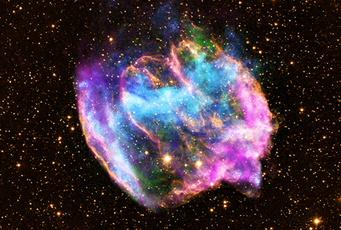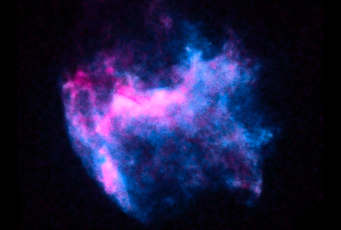Astronomers investigating a supernova remnant see nothing but swirls of gas. The lack of stellar remains means the explosion must have birthed a black hole only 1,000 years ago.
In 1066, William the Conqueror seized the throne of England in the midst of Europe’s Dark Ages. Around the same time (give or take a few years), our planet saw the light from an exploding star 26,000 light-years away, though the brief flare was too faint to be noticed by warring Earthlings.

The barrel-shaped supernova remnant, W49B, lies 26,000 light-years (about half the radius of the Milky Way) away. The star that produced this remnant exploded 1,000 years ago and probably produced a black hole that now lurks quietly amid the swirls of gas. This image combines X-ray (blue and green), infrared (orange), and radio (pink) data.
X-ray: NASA/CXC/MIT/L.Lopez et al.; Infrared: Palomar; Radio: NSF/NRAO/VLA
But this was no ordinary supernova (if such things can ever be ordinary). The 16-light-year-wide stellar remains, known as W49B, look distinctly barrel-shaped, unlike other remnants found in the Milky Way. That unique shape has made astronomers question the details of the star’s demise. Using 2½ days’ worth of Chandra X-ray Observatory images and spectra, Laura Lopez (MIT) and her colleagues suggest in a recent article published in the Astrophysical Journal that the star shot out two jets before collapsing into a black hole.
Lopez and her colleagues traced elements in the debris field and found an iron-rich bar of material running down the remnant’s center. X-ray images also showed that the remnant’s gas is elongated along the direction of this bar, an asymmetry that cannot be explained by the roughly spherical core-collapse that drives most supernovae.

This X-ray image shows emission from the iron (pink/purple) and the silicon (blue). The iron is distributed mostly along the bar, while silicon can be found throughout the remnant.
NASA / CXC / MIT / Laura Lopez & others
Since supernovae can give birth to both neutron stars and black holes, Lopez’s team looked for the faint X-ray glow of a neutron star — but they found nothing. Supernova explosions can send the resulting neutron stars whizzing off into space, but even if the explosion had given the neutron star a kick, the stellar corpse hasn’t had enough time to disappear. The explosion must have produced a black hole.
This black hole would be 1,000 years old, making it the youngest known in the Milky Way.
The black hole’s formation also explains the strange iron-rich bar. After the star’s core collapsed and infalling layers rebounded as a supernova, some of the exploding gas failed to escape the spinning black hole’s strong gravitational field, falling back into its gaping maw. As the gas spiraled in, it produced a pair of spectacular, short-lived jets that whipped out from the black hole’s poles, the remains of which expanded over time to form the iron-rich bar now seen running along the remnant’s center.
The spectra and images build a strong case for a rare explosion called a Type Ib/Ic supernova, the first of its kind discovered in the Milky Way. In these explosions, the star throws away its topmost layers of hydrogen in a strong stellar wind long before it loses its battle against gravity and explodes. This loss explains why Type Ib/Ic spectra don’t have hydrogen lines.
Type Ib/Ic supernovae are also known to produce some of the mysterious gamma-ray bursts (GRBs), bright flashes from short-lived jets that can be seen from across the universe. But to make a GRB, it’s not enough to have a supernova accompanied by a jet. Gamma-ray bursts require an intense, narrow jet, opening only a few degrees wide. If the jet were wider, no gamma-ray flash would have accompanied the supernova.
So was W49B a GRB? From our perspective, definitely not. Neither of W49B’s jets pointed our way, so no gamma rays would have flooded Earth 1,000 years ago. But some distant civilization lying in the jets’ line of sight might have seen the high-energy flash, and if that’s the case, W49B would be the closest remains of a GRB. Astronomers would have to measure the width of a jet that no longer exists to find out for sure.
That’s not entirely impossible. Lopez suggests that future studies might test whether gamma rays flooded the scene 1,000 years ago, either by measuring leftover radiation in the gas shell or by conducting simulations based on measurements of the iron-rich bar.
Whether this beautiful remnant was a GRB or not, it gives astronomers a unique opportunity to study the birth of a young black hole.
 3
3
Comments
Peter Kontrarski
February 18, 2013 at 5:53 pm
Interesting discovery by non-discovery, but the silicon x-rays (blue) look like a dog or a sheep; the iron (pink) looks like either two people in profileor a chalice. I‘m not seeing the bar.
You must be logged in to post a comment.
Gary Dennis
February 22, 2013 at 1:07 pm
Ummm. OK, the supernova became visible 1000 years ago in the visible spectrum and we've been receiving other radiation from the remnants, including a black hole, since the visible event. But this article clearly implies this black hole is only 1000 years old in absolute terms. That seems incorrect, since it took 26000 years for us to receive any indication of its existence.
If what the author is trying to say is that this 27,000 year old black hole is way younger than the others we're familiar with, in absolute terms or relative to the visible event, well and good - but the wording seems confusing.
You must be logged in to post a comment.
Shae Williams
March 1, 2013 at 8:08 pm
The terminology of the article is correct. Since it is 26,000 light years away from us, it means that the black hole is, in real-time, 27, 000 years old. We are viewing it as 1000 years old because it is the age that it was when the light from it reached us.
You must be logged in to post a comment.
You must be logged in to post a comment.